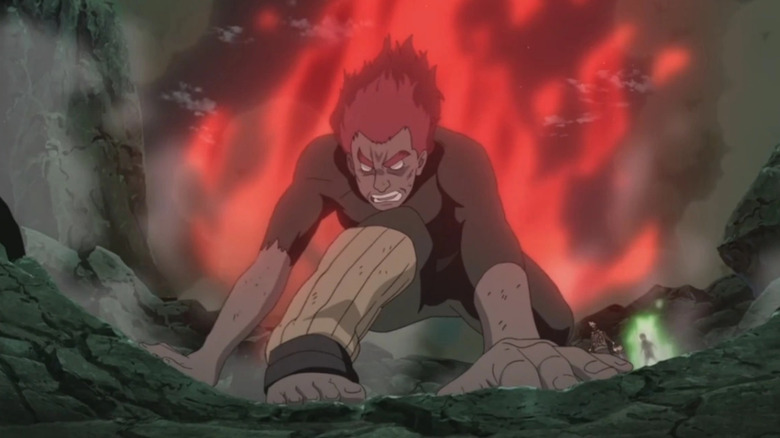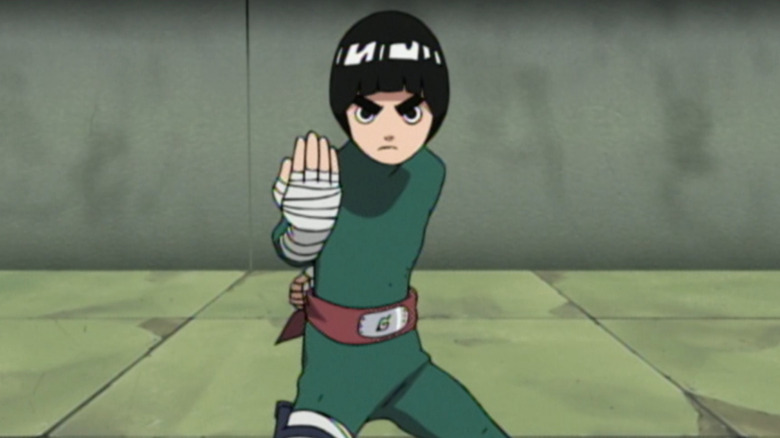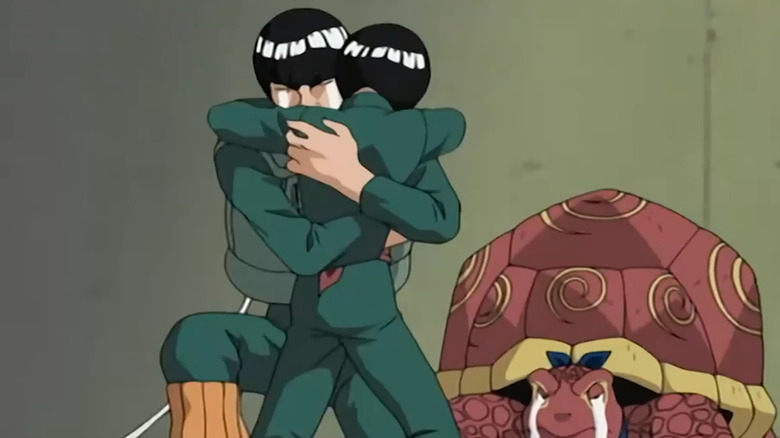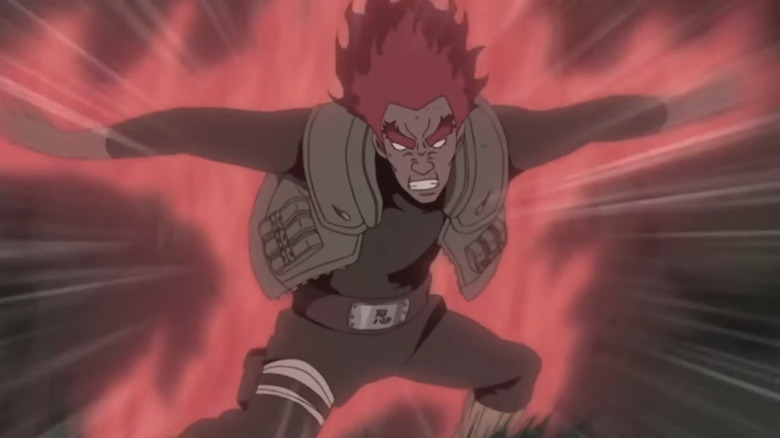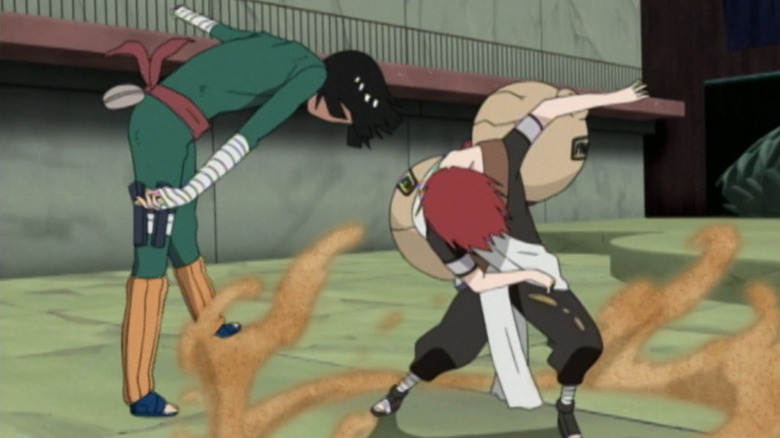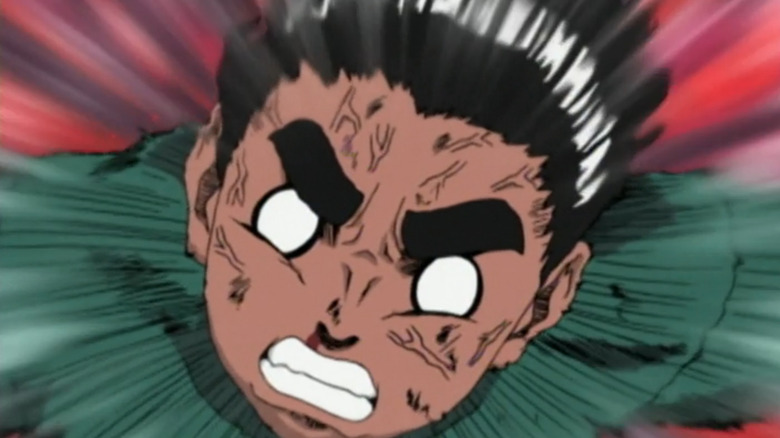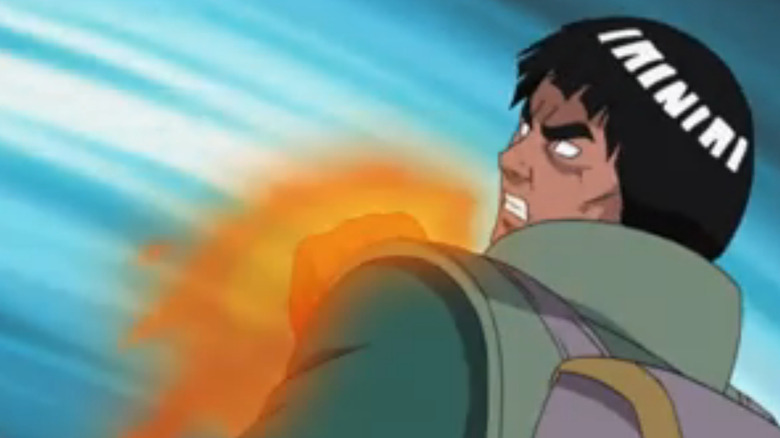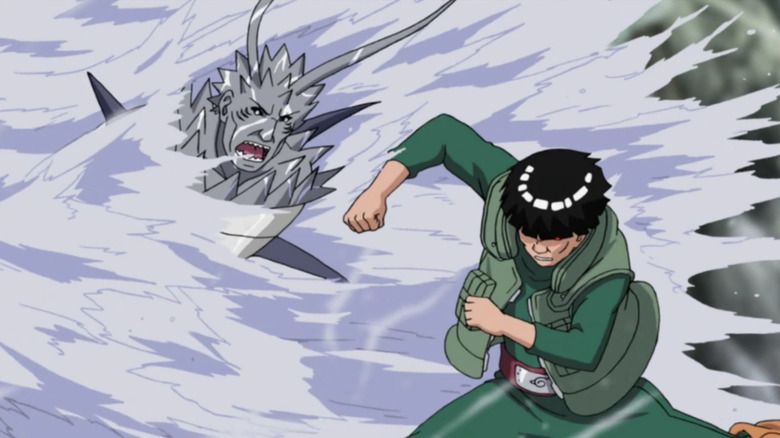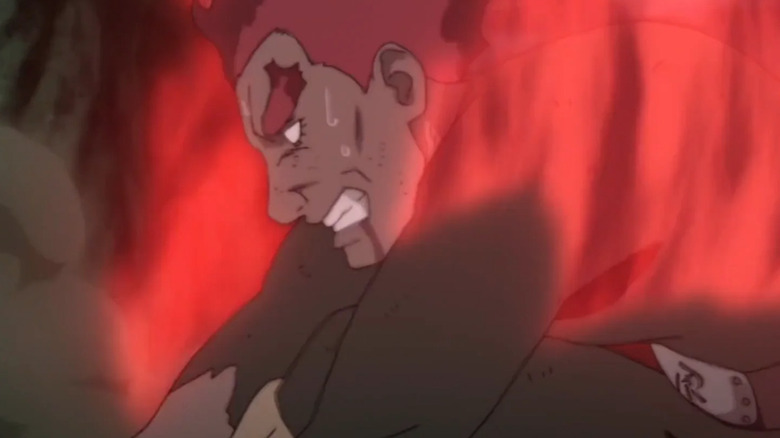Each Of The Eight Inner Gates In Naruto Explained
With hundreds of episodes in the bag and its spin-off going strong, it's safe to say that anime creator Masashi Kishimoto struck gold when he came up with "Naruto." Though the action scenes that propel the plot are great, this tale of a young ninja with lofty dreams of fame and success succeeds in no small part to the enormous cast of characters at its heart, and two of the most popular among them are the famous ninja, Might Guy, and his mentee, Rock Lee. As Naruto and Boruto's stories can make it feel like they're practically destined to achieve their goals, Might Guy's mentorship of Rock Lee clicks because they both had to fight so hard to achieve the level of skill they have.
Struggling to be a better fighter than his limited physical abilities allowed, Might Guy was introduced to the Eight Inner Gates by his father, Might Duy. Though Duy sadly died from the physical strain of opening the Gates all at once during an altercation, his easygoing and optimistic nature inspired Guy to continue pursuing his dreams. Seeing a lot of himself in the young Rock Lee, Guy trains with him, and Rock gradually learns to control the Tenketsu (or pressure points) in his body in order to open the Gates. We've also seen Rock's son, Metal, subconsciously tapping into this skillset, so there's no time like the present to take a look at what the Gates are and how they work.
The Gate of Opening
The "Naruto" concept of Tenketsu, or basic pressure points, controls the flow of energy, or Chakra, through a person's body. It takes its origins from Hinduism, though the concept has become a globally recognized belief structure. Identifying several different parts of the body that must remain open and aligned in order to keep our nerves and organs functioning properly is common sense for some, but it takes on a whole new life in "Naruto."
The Eight Gates are different from the religious concepts from which they take their inspiration in many key ways, but it nevertheless follows the same basic principle. Here, eight different gates are represented by various parts of the body. The first among them is the Gate of Opening, which in the brain and helps access its user's hidden strength, boosting their power from 20% to 100%.
Though Rock Lee stood out for not being adversely affected when using the First Gate, the Gate of Opening generally takes a heavy physical toll on its user, exhausting them. However, it allows the use of the Front Lotus move, which involves several sharp upward kicks that causes the opponent to come crashing down, often ending the fight. In Episode 48, "Gaara vs. Rock Lee: The Power of Youth Explodes," Rock's use of the Front Lotus surprises the rest of the cast as they watch him heroically hold his own and then win against Gaara. With Gaara's sand defenses rendering it difficult to strike him, Lee tapped into the Gates to win the battle, impressing Naruto in the process.
The Gate of Healing
While Kakashi was seen to be able to open the First Gate by accident once, Rock is the primary "Naruto" character to wield the Gates outside of Might Guy, who ultimately injured himself opening the Gates during the Fourth Great Ninja War. Though Guy was permanently sidelined by this, he's remained a proud supporter of Rock, who he views as being very much like a son. This special relationship is an extension of Guy's bond with his own father, who was never the best ninja but who mastered the Gates and protected Guy when it mattered most. Throughout Part 1, Rock learns to open all of the first five Gates, then eventually masters them all by the time he reaches adulthood.
Like the First Gate, the second is located in the brain, however, the first is found in the left hemisphere while the second is found in the right. This Gate is also referred to as The Gate of Rest, allowing for immediate rejuvenation, even when its user is mid-fight. In practice, it works as a souped-up extension of the First Gate, exemplifying its wielder's inherent strength by temporarily mending them and restoring them to 100%. While opening the First Gate allows for access to the Front Lotus, there isn't yet a move specifically associated with the Gate of Rest, leaving us to assume that the Front Lotus simply takes on that extra layer of finesse with the Second Gate flowing.
The Gate of Life
The Tenketsu of the Third Gate is found in the spinal cord, and opening this one causes the user to take on a bright red glow while their veins and muscles bulge with extra power. The Gates rely on the idea that we all have greater strength than we actually access on a regular basis, with the body imposing limitations that will prevent us from regularly harming ourselves due to going too far, too fast. With the Gates opened, the fighters have more abilities, but the toll on their bodies can cause lasting harm or even kill them. This is why Might Duy lived by the principle that one should only tap into these powers if defending something worth dying for, which he did when he opened all Gates to defend his son.
This Third Gate is even more visually impressive than the first two, and it allows its user to access the Reverse Lotus. With the threat of Gaara ramping up again in the episode, "The Fifth Gate: A Splendid Ninja is Born," Lee is forced to take increasing risks in order to get past his "Absolute Defense" which made him increasingly difficult to attack head-on. The Reverse Lotus drains Lee and leaves him completely vulnerable, with many questioning whether he would ever be able to fight again. This leaves Might Guy wracked with guilt for teaching him to access the Gates to begin with, though Rock's steely determination reminds him so much of himself.
The Gate of Pain
In the fight against Gaara, Rock Lee also opens the Fourth and Fifth Gates. Still, it very nearly kills him to do so and he is still sadly unable to win the fight. Though Lee delivers a final blow that should have made him the victor, Gaara's elusive defensive style of fighting undermines Lee's use of the Gates, making him one of the most dangerous early foes of the series. Lee opens the Gate of Pain in advance of using the Reverse Lotus, which has immediate physical effects. While he gains an extra burst of speed that helps him to use the Lotus with the utmost skill, he is visibly under duress when it happens, with his nose bleeding and his muscles starting to tear.
With this newfound speed on his side, the fight takes on greater proportion than ever, but even though Lee loses the battle, his loss still counts for something. Gaara is one of the show's most compelling recurring characters, serving as a sort of mirror image of Naruto due to their equally troubled childhoods. While Gaara uses this pain to covet ruthlessness, Naruto went in the opposite direction. Eventually, the group sees that Gaara is physically strong but physically frail, with his defensive measures being the result of deep inner pain. Naruto bests him in battle down the road, but Lee's struggle to find his weaknesses plays a major role in that.
The Gate of Limit
The final Gate that Lee opens in his fight against Gaara in Episode 50 is The Gate of Limit, otherwise known as The Gate of Closing. This is located in the stomach, and, much as the Gate of Pain amps up speed, this one increases physical strength. Though only three of the Gates need to be opened to access the Reverse Lotus, Lee taps into the first Five, showing his dedication to defeating Gaara even if it was not to be during this round. As the fight goes on, Might Guy is with his young pupil on the sidelines, and even he is surprised by the level of energy released by the determined Rock. Though the Limit excels by imposing retraction to add power to the strike, it has serious repercussions for Lee.
When Gaara is able to soften Lee's final blow by turning his gourd into sand and avoiding devastating fallout, he goes one step further over the line by using his sand to crush Lee's arm and leg. Moving in to finish Lee with the threat of possibly ending his life, Guy leaps to Lee's defense. Knocked unconscious by the fight, Rock Lee still manages to drag himself up, ready to finish the fight (which is considered the most unforgettable scene by "Naruto" fans). This causes Guy to weep with love for his pupil, who reminds him of his purpose as a teacher. Seeing Lee's weaknesses never bothered Guy as he knew the kid's dedication was stronger than any other's, so this fight bonds them even closer together despite its outcome.
The Gate of View
In Episode 15 of "Naruto: Shippūden," titled "The Secret Weapon is Called..." we get our first glimpse of The Gate of View, or The Gate of Joy. This is located in the stomach, and is among the most visually impressive manifestations of the Gates, enabling the use of a flashy, awe-inspiring move called The Morning Peacock. Even before that, the sheer power that radiates from the person accessing this Gate is enough to cause ripples in their immediate environment, displacing water and more. While the prior Gates tended to increase specific aspects of the fighter's skillsets, opening this Gate boosts the abilities gained from opening all of the previous Gates and then some.
Might Guy first taps this Gate in order to defeat the sadistic but incredibly powerful Kisame Hoshigaki. Utilized when a certain-kill strike is needed, the Morning Peacock comes in handy against such an unscrupulous foe as Kisame. This move sees Guy take on a green aura, with his punches flying so fast that the air around him quite literally catches flame. Though this defeat leads to a wild new subplot as Guy realizes that the corpse lying at his feet is not Kisame but rather someone he's never seen before, the power of the move and the enhanced abilities from opening the Gate are clear.
The Gate of Wonder
Otherwise known as The Gate of Shock, this one is located just below the stomach. Another Tenketsu with a visually interesting quirk, opening this Gate causes the user to secrete blue sweat, which causes an aura-like appearance when it evaporates. The move associated with this Gate is The Daytime Tiger, a stunning final blow that takes the power of a simple punch and multiplies it. Facing a palm forward, the user taps it with the other hand and forms a fist, creating air pressure. This forms an air pocket in the shape of a tiger that can easily end a fight, picking up compression as it moves and wreaking devastation when it lands.
Despite its mighty power, similar to the previous Gates, opening this one causes severe physical downsides. We first see Guy open this Gate in the "Naruto: Shippūden" episode, "Battle in Paradise! Odd Beast vs. The Monster!" While taking time to meditate in front of The Falls of Truth, Guy is attacked again by Kisame. The two engage in a high-stakes battle as Kisame pulls out many of his most impressive attacks. Guy taps into The Morning Peacock to dispel them but ultimately has to utilize The Daytime Tiger to end the fight. Confident that he's soon to sweep the board by using his Chakra-absorbing move, Kisame is stunned when Guy uses this incredible move, effectively ending the fight for the time being.
The Gate of Death
In "Naruto" mythos, there are only Eight Gates in the human body, with the final one perhaps fittingly being known as The Gate of Death. This title has ominous overtones, as opening it has quite literally caused death on some occasions. This Gate is located at the heart and requires the chest to be punctured by the user's thumb to tap into its power. Even with these many warnings in place, it's difficult to overestimate how dangerous opening this Gate can be, as it causes its host to heat up and catch fire. If left openly unchecked, it can quickly burn its user up, leaving only a trail of ash and cinder in its place.
Though this is a Gate best left unused outside of the direst circumstances, it allows its user to access the Evening Elephant and Night Guy moves. The Elephant revolves around a series of five devastating punches that can crack through even the most resilient armor. Meanwhile, Night Guy revolves around releasing steam which appears in the form of a dragon.
These moves were accessed in Episodes 420-421 of "Naruto: Shippūden," titled "Eight Gates Released Formation" and "The Sage of Six Paths." The end of the fight shows Guy deteriorating, the bones of his right leg shattered. Though he survives with help from Naruto, this effectively ends his life as a fighter. The Gates are powerful, wonderful things, but their downsides are extreme. However, Rock has been able to keep their power in check with his training from Guy.
